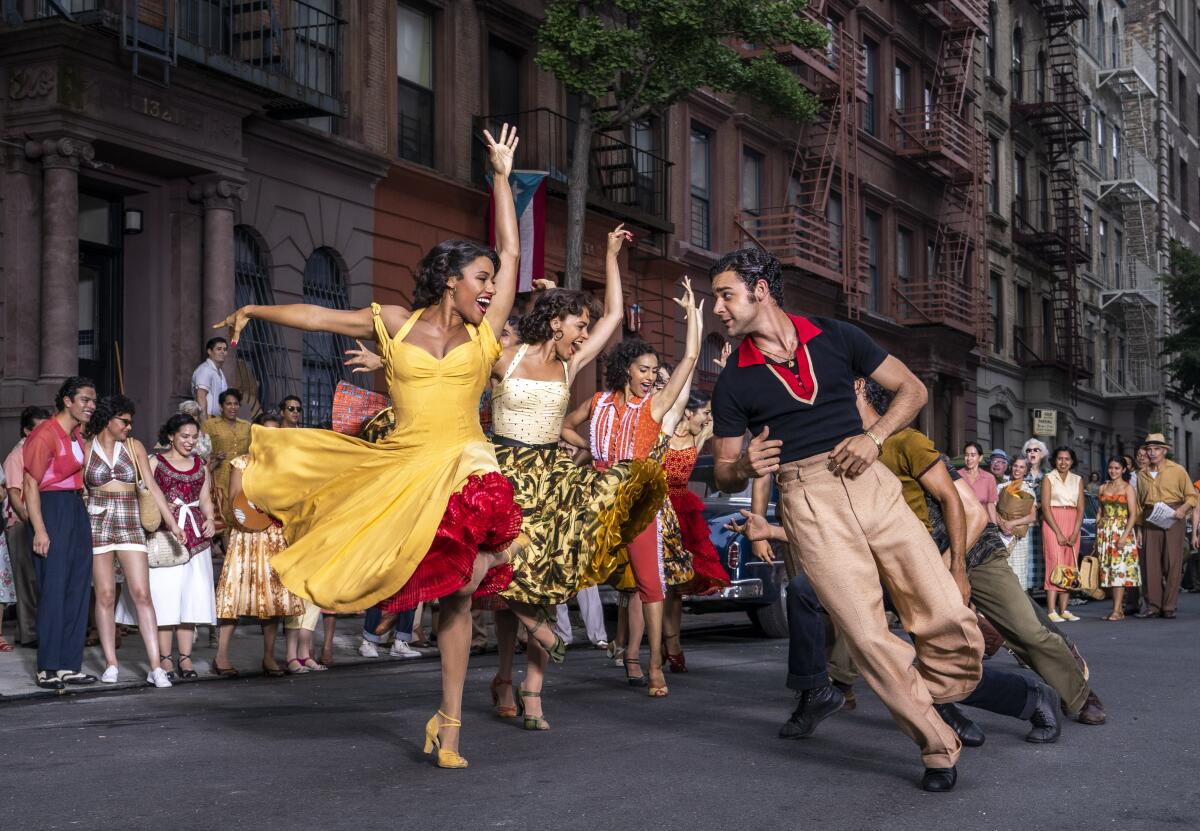Feedback: In defense of Steven Spielberg’s ‘West Side Story’

- Share via
Does Spielberg get this ‘Story’ right?
It’s a shame that Ashley Lee needed to smack down the new “West Side Story” so pointlessly [“‘West Side Story’ Is Out of Step,” Jan. 4]. Movies aren’t good at defining any given group. The idea that this work is a “classic case of cultural appropriation” is depressingly anti-art.
Steven Spielberg’s new film is wonderful — filled with life, energy, romance and a powerful drama. Both his version and Robert Wise’s 1961 classic are exceptional musicals. Cultural appropriation is one of those concepts that ultimately lead to ghettoizing the arts. Are we now to assume that only members of one cultural group can speak to the concerns of that group?
“West Side Story” is beloved not for its insights into the specifics of Puerto Rican culture — or into the culture of white gangs in New York. It’s a dramatic work that makes a plea for tolerance, understanding and acceptance between two different communities. Isn’t that a worthy and relevant message for today?
What can four middle-aged, gay, Jewish white guys (the creators of “West Side Story”) possibly have to say about bringing two warring communities together? Quite a lot, actually.
Harrison Engle
Los Angeles
::
Bigger is not always better. I saw “West Side Story” originally in New York in 1957. In fact, I saw it three times, I was so enthralled with it. Being a young actor studying in New York, I would get standing room. I’ve seen many other productions of the show here in Los Angeles and elsewhere. It was one of those shows that even if the cast was not up to professional level, it still worked.
Steven Spielberg’s adaptation works, but I think that’s in spite of some of his embellishments.
A few things that bothered me.
These aerial views of New York for me add nothing. West Side Story to me is a very intimate story.
The original “America” takes place on the roof of one of the tenements. Now the whole neighborhood is partaking in the choreography.
The “Something’s Coming” song is a very personal feeling for Tony, but now he’s filling shelves in the store and singing it to Rita Moreno. This does not add to his feeling that something momentous is coming, it diminishes it.
“I Feel Pretty” was originally done in Maria’s bedroom as she is discovering that maybe she is pretty. Now Spielberg has made it into another big production number in Gimbels. It does not enhance the emotion she is feeling. It again diminishes the emotion to make it into a production number.
Now we have Doc’s store run, apparently, by his widow who is Puerto Rican. It strains credulity to think the Jet’s would frequent a store run by Puerto Ricans.
“Gee Officer Krupke” number always worked, I think, because we get to see the Jet’s relationship with him. But now we see this number at an empty police station about a person we have never really seen them have any kind of relationship with. It didn’t make much sense to me, and I’ve seen the show many times. I wonder what people who are not too familiar with the show think.
Rita Moreno sings “Somewhere” in a very low-key way. Here is where Spielberg should have opened it up. This is a song of hope and reconciliation, where they all should be partaking, for at last the whole community is realizing the tragedy and waste their collective behavior has brought.
Bix Barnaba
Van Nuys
A rock ‘n’ roll star
Regarding Mikael Wood’s appreciation of Ronnie Spector, “In Awe of Her Heroic Stance” [Jan. 14]: I’m old enough to remember when the Ronettes’ “Be My Baby” first aired on the radio. At the time, I liked the song but didn’t think much more of it. Recently, the death of Ronnie Spector brought it to mind and I realized that the power of Ronnie’s voice had created a pleasant earworm so powerful that I can easily hear her soaring voice over and over in my mind.
I wasn’t aware of the extent of the influence that Ronnie had on subsequent musicians in rock ‘n’ roll, but Wood explained it well in his piece. He also perfectly captured the power of her singing and made me appreciate it even more.
Wood nailed it.
Dan Branstrom
Desert Hot Springs
::
Ronnie Spector’s vocal is spectacular. Phil Spector’s production is magnificent. But the foundation of “Be My Baby” is the song itself. I think it’s remiss not mentioning Jeff Barry, Ellie Greenwich and Ship Spector as the writers of this timeless, great song, and countless others.
Ken Hirsch
Los Angeles
Debating a Los Angeles movie
Greg Braxton paints Lawrence Kasdan’s film “Grand Canyon” as a paean to white privilege [“‘Grand’ Visions,” Jan. 9]. It sounds to me more like a paean to white angst and fear than privilege.
According to Braxton, in “Grand Canyon,” dark-skinned people are the enemy. In the land of critical race theory, white-skinned people are the enemy.
Instead of vilifying one another, let’s begin treating each other as valid human beings. Nobody is perfect and they never will be. We can tolerate a few warts, OK.
Nathan Post
Santa Barbara
::
While many aspects of the film may merit reevaluation, the questions the film raised on the portrayal of gun violence in movies are more relevant than ever as gun violence surges and over 100 people in the U.S. are shot and killed every day.
Bridget McCarthy
Los Angeles
::
While Lawrence Kasdan is arguably one of Hollywood’s most successful screenwriters and does not need me or anyone else to rise to his defense, Greg Braxton’s belated panning of “Grand Canyon” irked me sufficiently into doing so.
William Goldman once said, “There are no good or bad movies. There are movies that either work or don’t work at the time they come out.”
Addressing the film’s handling of race relations, Braxton is 31 years late.
I think a great film should possess the humility to not claim to have all the answers while still being confident in its assertion that it has a unique and creative way in which to pose the questions. By this measure — and Braxton’s critique ironically enough seconds the notion — “Grand Canyon” remains an admirable success.
William P. Bekkala
West Hollywood
Tears over closed Milk
Regarding “January Ennui Calls for Ice Cream” [Jan.17]: Mary McNamara could get her ennui taken care of if all the ice cream trucks in Los Angeles decided to congregate once a week for her.
But that wouldn’t solve my ice-cream-versus-ennui problem. Every Wednesday for the past number of years I’ve replenished my week’s supply of Coffee Toffee ice cream at Milk
With me, it’s an addiction that needs to be fed. But the last time we pulled up in front of the shop the windows were shaded and the doors were locked. Milk is out of business.
What’s an ice cream addict to do? Can anyone out there help me? Is there an ice cream truck or parlor that offers Coffee Toffee?
Bob Klein
Los Angeles
Book recommendation
Thank you for Thursday’s article recommending books addressing inequality [“Fight Inequality With These 10 Reads,” Jan. 13]. I’d like you to consider another book on a similar subject.
“Halfway Home,” by Reuben Jonathan Miller, addresses the many challenges facing formerly incarcerated persons that virtually guarantee recidivism. There are systemic issues I have never seen addressed that lead to incarceration and its aftermath. The topic has been discussed in bits and pieces before, but Miller, who teaches at the University of Chicago School of Social Service Administration, addresses the problem from both a scholarly perspective and real-life experiences of these people.
While I am certain parole officers and the social service network established to be of assistance have experienced frustration with noncompliant clients, this book puts the situation in human terms and I think it would be an important read for everyone involved in the system.
Arlette Chew
Lawndale
When the drums stop
I am sorry Sheriff Drumman‘s cherry red Ford F-350 pickup truck and its 13-piece drum set were stolen [“Truck Theft Hit Hard,” Jan. 14, by Kenan Draughorne], but I am not going to miss listening to them lacerate the ambient peace of Friday afternoons at Hope and 7th Street downtown when I am trying to work.
Jim Moore
Los Angeles
Politics in the comics
I really object to your continuing to publish the Sunday Doonesbury on the cartoon page. It is nothing but a hate-filled anti-Trump political hit piece that has no place among the cartoons — nor anywhere else except perhaps you opinion page, in my opinion.
Ed Martin
Los Angeles
More to Read
The biggest entertainment stories
Get our big stories about Hollywood, film, television, music, arts, culture and more right in your inbox as soon as they publish.
You may occasionally receive promotional content from the Los Angeles Times.











